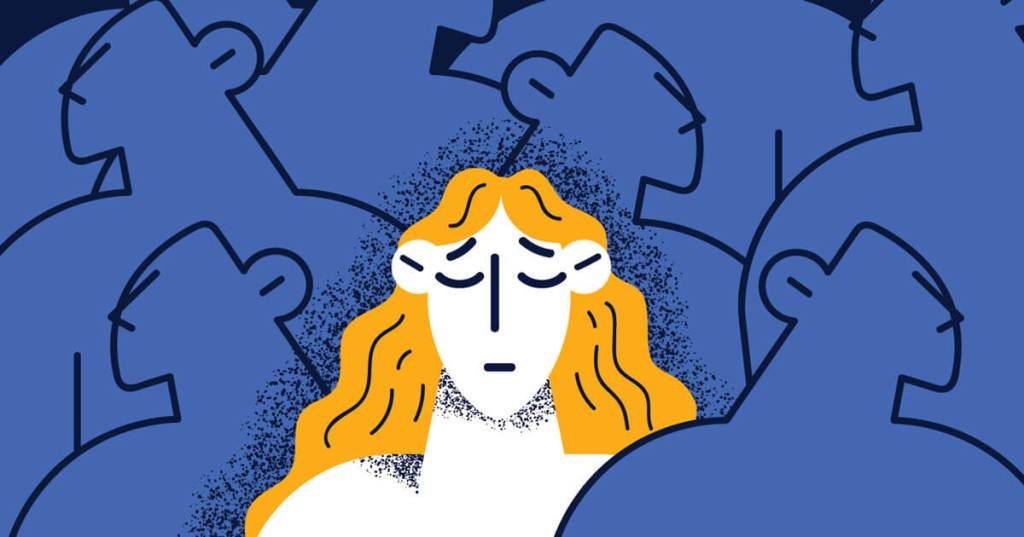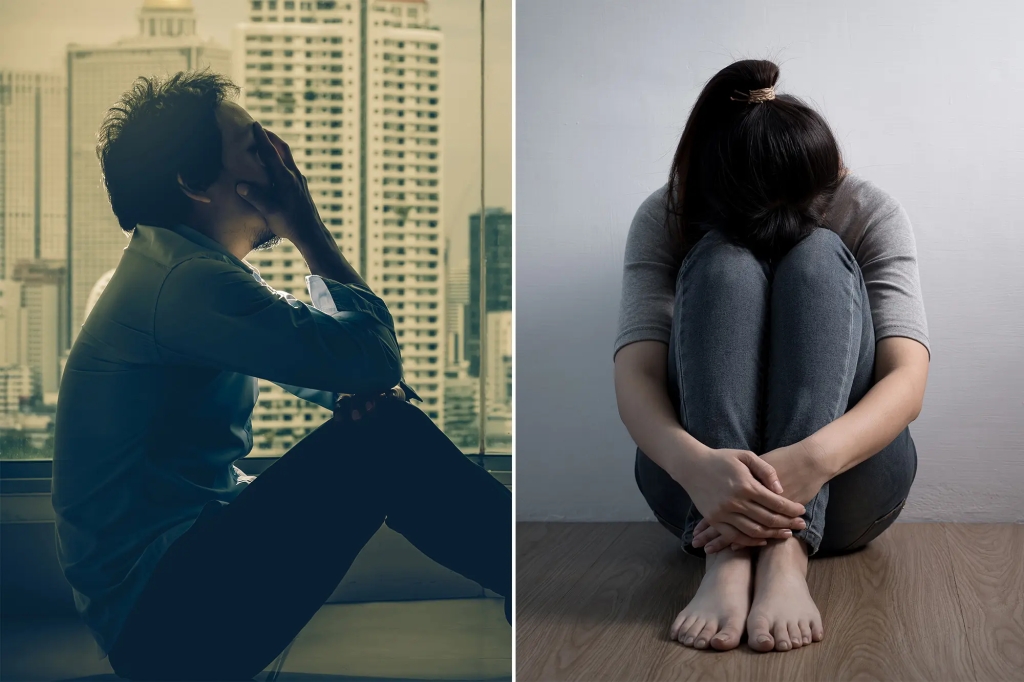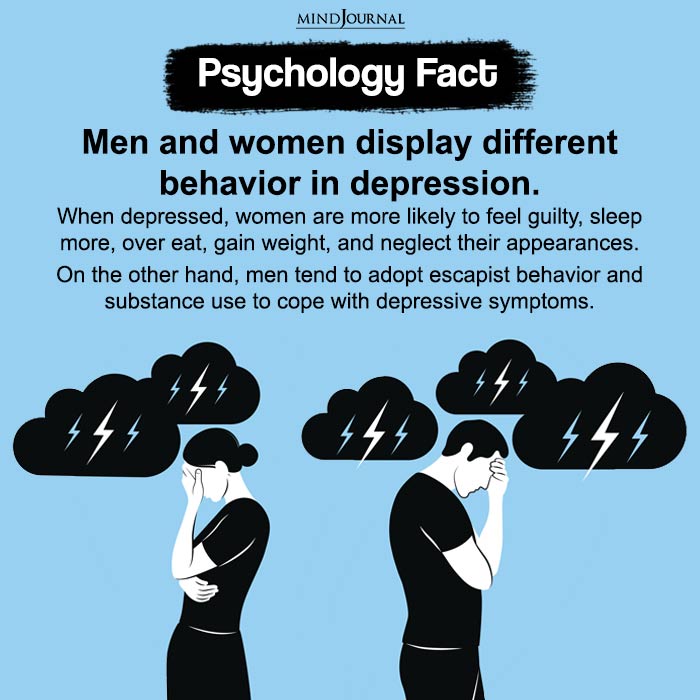Trước giờ người ta đã ghi nhận rằng có sự khác biệt về giới tính trong tỷ lệ mắc trầm cảm, trong đó, phụ nữ thường mắc trầm cảm điển hình cao hơn nam giới. Nguy cơ này tồn tại độc lập với chủng tộc hoặc sắc tộc.
It has been widely documented that there are gender differences in depression prevalence, with women experiencing major depression more often than men. This risk exists independent of race or ethnicity.

Một nghiên cứu quy mô lớn năm 2017 đã phát hiện ra rằng khác biệt trong giới tính xuất hiện từ khoảng độ tuổi 12, với các bé gái và phụ nữ có nguy cơ mắc trầm cảm cao hơn gấp hai lần so với nam giới. Một vài yếu tố nguy cơ đã được nghiên cứu chỉ ra, giúp giải đáp cho sự khác biệt về giới này trong tỷ lệ mắc trầm cảm.
One large-scale 2017 study found that these gender differences emerge starting at age 12, with girls and women being twice as likely as men to experience depression.1 Several risk factors have been studied that might account for gender differences in rates of depression.
Tổng quan. At a Glance
Phụ nữ và bé gái mắc trầm cảm cao hơn gấp hai lần so với đàn ông và các bé trai. Có một vài yếu tố góp phần vào tình trạng này, bao gồm khác biệt trong hormone, hòa nhập xã hội, vai trò xã hội, cơ chế ứng phó và căng thẳng trong cuộc sống. Tuy nhiên, ta cũng cần lưu ý rằng phụ nữ cũng dễ đi tìm kiếm trợ giúp hơn và trầm cảm thể hiện ở nữ cũng khác ở nam, điều này có thể hiểu là nam giới thường chưa được chẩn đoán đầy đủ hoặc bị chẩn đoán nhầm. Hãy cùng tìm hiểu về lý do tại sao phụ nữ lại dễ bị chẩn đoán mắc trầm cảm hơn nam giới.
Women and girls are twice as likely to have depression compared to men and boys. There are several factors that may play a role in this, including differences in hormones, socialization, social roles, coping mechanisms, and life stress. However, it is also important to note that women are more likely to seek help and that depression may present differently in men, which may mean that men are often under or misdiagnosed. Keep reading to learn more about why women are more likely to be diagnosed with depression.

Dấu hiệu trầm cảm thường gặp ở phụ nữ. Common Signs of Depression in Women
Thay đổi hormone. Hormonal Differences
Chúng ta đều biết khoảng thời gian khởi phát rối loạn trầm cảm cao nhất ở nữ giới lại trùng hợp với những năm trong độ tuổi sinh sản (từ 25 đến 44 tuổi), các yếu tố nguy cơ về hormone có thể góp phần. Estrogen và progesterone đã được chứng minh là gây ảnh hưởng lên chất dẫn truyền thần kinh, nội tiết thần kinh và nhịp sinh học vốn có thể làm trầm trọng thêm các rối loạn khí sắc.
Given that the peak onset of depressive disorders in women coincides with their reproductive years (between the ages of 25 to 44 years of age), hormonal risk factors may play a role. Estrogen and progesterone have been shown to affect neurotransmitter, neuroendocrine, and circadian systems that have been implicated in mood disorders.2

Đúng là phụ nữ có thể mắc các rối loạn khí sắc có liên quan đến chu kỳ kinh nguyệt, như rối loạn tâm thần tiền kinh nguyệt (PMDD), một rối loạn khí sắc định hình bởi các triệu chứng trầm cảm xuất hiện trước thời điểm bắt đầu chu kỳ kinh nguyệt, cũng cho thấy mối quan hệ giữa hormone sinh dục nữ và tâm trạng.
The fact that women can experience mood disorders associated with their menstrual cycle, such as premenstrual dysphoric disorder (PMDD), a mood disorder characterized by depressive symptoms that occur prior to the start of the menstrual cycle, also points to a relationship between female sex hormones and mood.
Mặc dù mãn kinh là thời gian phụ nữ có ít nguy cơ mắc trầm cảm hơn, nhưng tiền mãn kinh lại là khoảng thời gian có nguy cơ mắc tăng lên đặc biệt cao với nhóm có tiền sử bị trầm cảm điển hình. Các yếu tố hormone khác có thể góp phần vào nguy cơ mắc trầm cảm ở nữ giới là sự khác biệt về giới có liên hệ đến trục ba cơ quan vùng dưới đồi-tuyến yên-tuyến thượng thận (HPA) và tuyến giáp.
Although menopause is a time when a woman’s risk of depression declines, the peri-menopausal period is a time of increased risk for those with a history of major depression. Other hormonal factors that may contribute to a woman’s risk for depression are sex differences related to the hypothalamic-pituitary-adrenal (HPA) axis and thyroid function.
Khác biệt trong hòa nhập xã hội. Socialization Differences
Các nhà nghiên cứu đã phát hiện ra rằng khác biệt về giới trong xã hội hóa có thể đóng một vai trò tác động vào tỷ lệ mắc trầm cảm. Các bé gái thường bị xã hội định hình là biết bảo bọc và để tâm đến ý kiến của mọi người, trong khi các bé trai thường được khuyến khích trau dồi sự tự lập và cảm giác làm chủ trong đời sống.
Researchers have found that gender differences in socialization could play a role in rates of depression as well.3 Girls are generally socialized to be more nurturing and sensitive to the opinions of others, while little boys are often encouraged to develop a greater sense of mastery and independence in their lives.
Xã hội hóa sự nam tính nhấn mạnh những quy chuẩn như khắc kỷ, cứng rắn và tránh bất cứ thứ gì bị cho là nữ tính, bao gồm cả việc thể hiện cảm xúc. Một số nhà nghiên cứu cho rằng dạng xã hội hóa này có thể làm xuất hiện trầm cảm ở nam theo một cách khác biệt.
Masculine gender socialization emphasizes norms such as stoicism, toughness, and the avoidance of anything perceived as feminine, including displays of emotion. Some researchers suggest that this type of socialization may cause depression to manifest differently in men.4
Vai trò xã hội. Social Roles

Có học thuyết cho rằng phụ nữ ở nhà làm nội trợ và làm mẹ sẽ cảm thấy vai trò của mình bị xã hội coi thường. Trong khi đó, phụ nữ theo đuổi sự nghiệp bên ngoài lại đối mặt với sự phân biệt đối xử và bất bình đẳng trong công việc hoặc rơi vào thế xung đột giữa vai trò làm vợ làm mẹ và công việc của mình.
It has also been theorized that women who become housewives and mothers may find their roles devalued by society. Meanwhile, women who pursue a career outside the home may face discrimination and job inequality or may feel conflicts between their role as a wife and mother and their work.
Xã hội hóa vai trò giới và đặc tính giới có liên quan đến mức độ ứng phó với căng thẳng và tác động căng thẳng gây ra cho sức khỏe. Các nhà nghiên cứu đã phát hiện ra rằng kiểu xã hội hóa này làm lợi cho đàn ông nhiều hơn trong vấn đề sức khỏe nói chung.
The socialization of gender roles and gender traits has been associated with how well people cope with stress and the effects that stress has on health. Researchers have found that such socialization benefits men in terms of overall health.5
Các yếu tố xã hội. Societal Factors
Ảnh hưởng từ xã hội, bao gồm bất bình đẳng giới, nghèo đói, chênh lệch thu nhập và tiếp xúc với bạo lực cũng có thể làm tăng nguy cơ mắc trầm cảm ở phụ nữ. Một số nhà nghiên cứu còn cho rằng tỷ lệ nạn nhân hóa và bất bình đẳng giới cao hướng đến phụ nữ cũng giúp giải thích tỷ lệ mắc trầm cảm gia tăng ở nhóm này.
Societal influences, including gender inequality, poverty, earning disparities, and exposure to violence, can also increase the risk of depression in women. Some researchers suggest that the higher rates of victimization and gender inequality experienced by women help explain the increased rates of depression.1
Kiểu ứng phó. Coping Style
Nghiên cứu cũng cho thấy phụ nữ thường dùng các kiểu ứng phó tập trung nhiều hơn vào cảm xúc, chìm đắm trong suy tư – nghĩ nhiều về những vấn đề của mình trong đầu; trong khi nam giới có kiểu ứng phó tập trung nhiều hơn vào vấn đề, gây xao nhãng để giúp họ quên đi khó khăn.
Studies also show that women tend to use a more emotion-focused, ruminative coping style—mulling their problems over in their minds; while men tend to use a more problem-focused, distracting coping style to help them forget their troubles.6
Có giả thiết cho rằng dạng ứng phó chìm đắm trong suy nghĩ này có thể đưa đến nhiều giai đoạn trầm cảm nghiêm trọng hơn và góp phần khiến phụ nữ dễ mắc căn bệnh này hơn.
It has been hypothesized that this ruminative coping style could lead to longer and more severe episodes of depression and contribute to women’s greater vulnerability to depression.

Các sự kiện căng thẳng trong cuộc sống. Stressful Life Events
Bằng chứng cho thấy, trong suốt cuộc đời, phụ nữ có thể gặp nhiều sự kiện gây căng thẳng hơn và nhạy cảm hơn với các sự kiện này so với nam giới.
Evidence suggests that, throughout their lifetimes, women may experience more stressful life events and have a greater sensitivity to them than men.
Nữ thanh thiếu niên thường ghi nhận có nhiều sự kiện tiêu cực trong cuộc sống hơn nam thanh thiếu niên – thường có liên quan đến mối quan hệ với cha mẹ và bạn bè – và có mức căng thẳng liên quan cao hơn.
Adolescent girls tend to report more negative life events than boys—usually related to their relationships with their parents and peers—and experience higher levels of distress related to them.7
Nghiên cứu về nữ giới trưởng thành cũng phát hiện ra phụ nữ dễ trầm cảm khi phản ứng lại một sự kiện căng thẳng hơn nam giới và đã có trải nghiệm một sự kiện căng thẳng xuất hiện trước một giai đoạn trầm cảm điển hình.
Studies of adult women have found that women are more likely than men to become depressed in response to a stressful life event and to have experienced a stressful event prior to a major depressive episode.8
Tuy nhiên, tỷ lệ mắc trầm cảm cũng khá thống nhất trên toàn thế giới, cho thấy ảnh hưởng sinh học đóng vai trò lớn nhất và các yếu tố như tình trạng kinh tế xã hội, giáo dục, chủng tộc, chế độ ăn uống và văn hóa đều là những yếu tố tác động thứ cấp hoặc cộng kèm.
However, depression prevalence rates also tend to be fairly consistent globally, which may suggest that biological influences play the largest role and that factors such as socioeconomic status, education, race, diet, and culture are secondary or compounding influences.
Khác biệt trong chẩn đoán. Diagnosis Differences
Các nhà nghiên cứu cũng cho rằng thực sự vẫn chưa có khác biệt gì nhiều trong tỷ lệ mắc ở nam và nữ. Các nhà nghiên cứu này cũng đưa ra một quan điểm cho rằng trong thực tế thì phụ nữ sẽ tìm kiếm hỗ trợ nhiều hơn nam giới hoặc ghi nhận triệu chứng theo cách khác, khiến họ bị chẩn đoán mắc nhiều hơn nam giới.
Researchers have also suggested that there may actually be no difference in prevalence between men and women. These researchers have proposed the idea that it may actually be that women seek help more often than men or report their symptoms differently, leading to them being diagnosed more often than men.
Một số nghiên cứu chỉ ra rằng không chỉ có đàn ông bị trầm cảm khác với phụ nữ, mà trầm cảm ở nam giới còn chưa được chẩn đoán đúng mức.
Some research indicates that not only may men experience depression differently than women do, but depression among men may also be underdiagnosed.
Đàn ông thường hay có các triệu chứng như tức giận, cáu bực, rối loạn giấc ngủ, và sử dụng chất. Họ cũng có thể mô tả triệu chứng trầm cảm của mình là “căng thẳng” thay vì là cảm giác buồn bã.
Men tend to experience symptoms such as anger, irritability, sleep disturbances, and substance use. They are also more likely to describe depressive symptoms as “stress” rather than feelings of sadness.4
Một nghiên cứu xuất bản trên tờ JAMA psychiatry phát hiện ra rằng trầm cảm được đo lường bởi những thứ gọi là “triệu chứng nam nhi”, “đàn ông thực tế lại có tỷ lệ mắc trầm cảm cao hơn một chút (26.3% nam giới và 21.9% phụ nữ.)
One study published in JAMA Psychiatry found that when depression was measured with these so-call “male symptoms,” men actually had somewhat higher rates of depression (26.3% for men and 21.9% for women).9
Các nhà nghiên cứu khác cũng lưu ý rằng tỷ lệ 2:1 trong chẩn đoán mắc trầm cảm điển hình không liên quan gì đến sự xuất hiện các triệu chứng trầm cảm cận lâm sàng. Bằng chứng cho thấy nhiều thanh thiếu niên và người trưởng thành xuất hiện các triệu chứng trầm cảm gây tổn hại đáng kể nhưng lại không đáp ứng đủ tiêu chuẩn chẩn đoán dành cho một rối loạn trầm cảm.
Other researchers have noted that the 2:1 ratio for the diagnosis of major depression does not account for the experience of sub-clinical depression symptoms. Evidence suggests that many teens and adults experience symptoms of depression that cause significant impairment but do not meet the diagnostic criteria for a depressive disorder.1

Điều cần ghi nhớ. Keep in Mind
Trầm cảm là một bệnh lý phức tạp không chỉ bị gây ra bởi một lý do đơn giản. Cần nghiên cứu thêm để hiểu rõ sự khác biệt về giới trong tỷ lệ mắc và chẩn đoán mắc trầm cảm. Nghiên cứu hiện có cho rằng sự khác biệt về sinh học giữa nam và nữ đóng vai trò đáng kể giúp giải thích sự khác biệt này. Mong đợi văn hóa, vai trò giới, và tình trạng chẩn đoán chưa đầy đủ về trầm cảm ở nam giới cũng có thể là những yếu tố góp phần.
Depression is a complex condition that does not have a single, simple cause. Further research is needed to understand sex differences in rates of depression and its diagnosis. The existing research suggests that biological differences between men and women play a significant part in explaining these differences. Cultural expectations, gender roles, and the underdiagnosis of depression in men may also be contributing factors.
Tham khảo. Sources
Salk RH, Hyde JS, Abramson LY. Gender differences in depression in representative national samples: Meta-analyses of diagnoses and symptoms. Psychol Bull. 2017;143(8):783-822. doi:10.1037/bul0000102
Wharton W, Gleason CE, Olson SR, Carlsson CM, Asthana S. Neurobiological underpinnings of the estrogen-mood relationship. Curr Psychiatry Rev. 2012; 8(3): 247-256. doi:10.2174/157340012800792957
Altemus M, Sarvaiya N, Epperson CN. Sex differences in anxiety and depression clinical perspectives. Front Neuroendocrinol. 2014;35(3):320-30. doi:10.1016/j.yfrne.2014.05.004
Sileo KM, Kershaw TS. Dimensions of masculine norms, depression, and mental health service utilization: Results from a prospective cohort study among emerging adult men in the United States. Am J Mens Health. 2020;14(1):1557988320906980. doi:10.1177/1557988320906980
Mayor E. Gender roles and traits in stress and health. Front Psychol. 2015;6:779. doi:10.3389/fpsyg.2015.00779
Cholankeril R, Xiang E, Badr H. Gender differences in coping and psychological adaptation during the COVID-19 pandemic. Int J Environ Res Public Health. 2023;20(2):993. doi:10.3390/ijerph20020993
Hamilton JL, Stange JP, Abramson LY, Alloy LB. Stress and the development of cognitive vulnerabilities to depression explain sex differences in depressive symptoms during adolescence. Clin Psychol Sci. 2015;3(5):702-714. doi:10.1177/2167702614545479
Cohen S, Murphy MLM, Prather AA. Ten surprising facts about stressful life events and disease risk. Annu Rev Psychol. 2019;70(1):577-597. doi:10.1146/annurev-psych-010418-102857
Martin LA, Neighbors HW, Griffith DM. The experience of symptoms of depression in men vs women: Analysis of the National Comorbidity Survey Replication. JAMA Psychiatry. 2013;70(10):1100-6. doi:10.1001/jamapsychiatry.2013.1985
Nguồn: https://www.verywellmind.com/why-is-depression-more-common-in-women-1067040
Như Trang.
